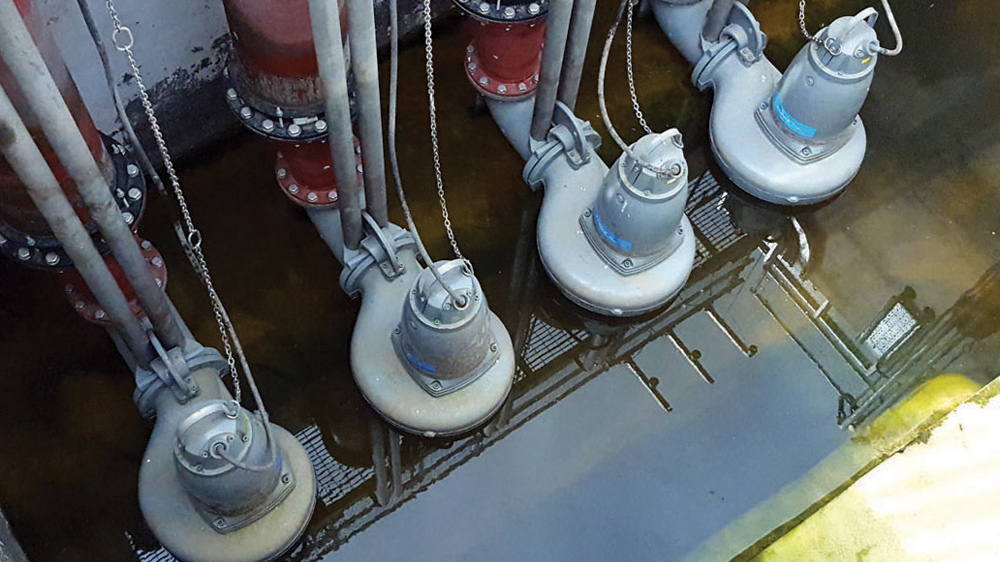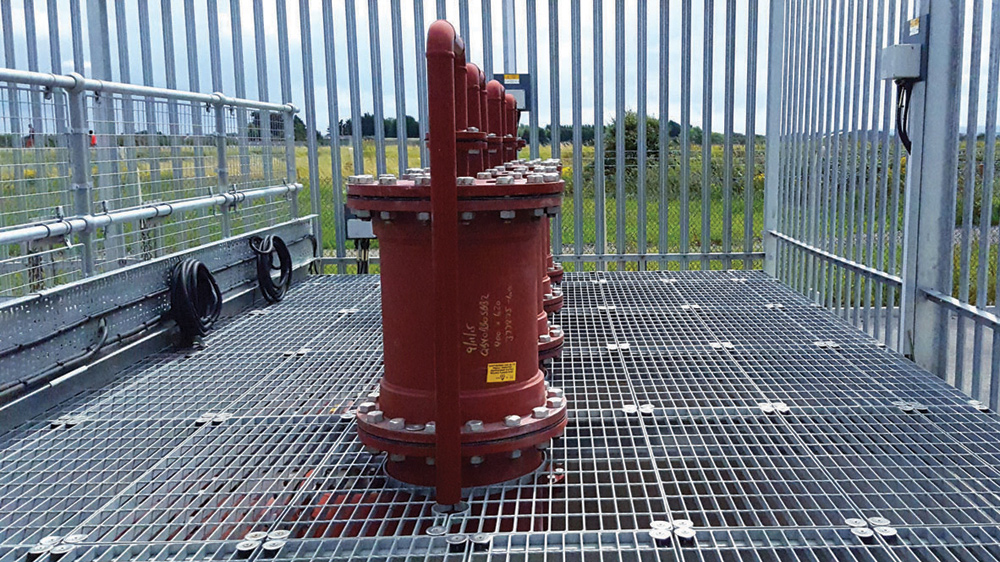Highbridge SPS Stormwater UV Disinfection (2016)

UV kiosk southern elevation - Courtesy of Wessex Water
Being classed as ‘poor’ quality, the bathing water at Burnham Jetty was predicted to fail under the revised Bathing Water Directive (rBWD). Investigations during AMP5 showed that improvements to sewage overflows at Highbridge and Bridgwater were necessary to improve compliance; with disinfection of the stormwater discharge at Highbridge Sewage Pumping Station (SPS) being identified for early completion within AMP6. Situated on the west coast of Somerset, Highbridge SPS is the terminal sewage pumping station for the Highbridge and Burnham-On-Sea catchment areas.
Project need
The National Environment Programme (NEP) for AMP6 includes the requirement for improvements at Highbridge and Sloway Lane SPS, stating:
“3 spills per bathing season at 50m3 aggregated (Highbridge SPS SSO (CSO), Sloway Lane SPS (CSO)), or UV disinfection of Highbridge SPS SSO (CSO) and 3 spills per bathing season at 50m3 Sloway Lane SPS (CSO). Must comply with EA screening policy. Must comply with EA PSEO policy requirements.”
Preparation for PR14 showed that the ‘traditional approach’ to limiting spills to 3 per bathing season would require approximately 17,000m3 of additional stormwater storage.
Due to limited land availability, the size and cost of storage, and the length of time to plan and construct them, the more innovative UV disinfection option was preferred. Wessex Water’s AMP6 business plan therefore included stormwater UV disinfection at Highbridge SSO as a named quality project.
The more sustainable long-term goal will be to reduce the inflow and infiltration in the sewerage system to reduce the spill frequency. Work will start towards this in AMP6 by developing an Infiltration Reduction Plan and carrying out IUDM work within the catchment.

Highbridge UV compound – Courtesy of Wessex Water
Highbridge Sewage Pumping Station
Highbridge SPS comprises an inlet pumping station, coarse screens and storm tanks as follows:
- Inlet pumping station with 3 (No.) screw pumps.
- Emergency overflow with a Huber Technology (Rotamat) screen. Consent requires 12mm-1D screen.
- 2 (No.) Longwood storm screens on inlet to the storm tanks, and a Huber Rotamat screen on the discharge. Consent requires 6mm-2D screens.
- 4 (No.) rectangular storm tanks with a total capacity of 5,039m3.
Flows up to 300l/s are lifted and passed forward to West Huntspill STW, situated across the River Brue, where flows are treated via settlement tanks and an activated sludge process before being disinfected by UV irradiation. Flows between 300-1,950l/s are lifted before over-flowing through the storm screens and into the storm tanks.
The existing site is located behind the sea defences on the Brue Estuary. To the south, west and north the land is an open amenity owned by Sedgemoor District Council. Settled storm flows are discharged into the tidal estuary of the River Brue. This is part of the Severn Estuary Ramsar, an internationally important wildlife site, SAC, SPA and Bridgwater Bay SSSI. The site is close to a regionally or locally important County Wildlife Site, Apex Park.

(left) Existing storm tanks and (right) existing SPS, new channel and the River Brue – Courtesy of Lewis CE
AMP5 preparations
Wessex Water engaged MWH for expert advice in various areas:
- Site based testing for collection of the data required to enable discussions with the EA on permit conditions.
- Coordinating collimated beam testing in order to select the target dose.
- Developing the preliminary design of a UV irradiation system involving validated * UV reactors for the treatment.
- Assisting with the pre-application submission to the Environment Agency (EA), with recommendations for specific permit conditions relating to target UV dose.
* UV reactor performance is tested over a range of inlet conditions, including UV transmittance and flow, to test the log reduction of standard microbes achieved by a given UV system under controlled conditions. The “validated” reactor can then be applied to any wastewater type, provide it fits within the range of parameters tested.
The 600l/s design flow was selected to ensure fewer than three untreated spills per bathing season based upon sewer modelling and the assessment of spill frequency during the previous 5 years data. Flows in excess of this will be discharged direct to the outfall untreated.

Lift PS and UV MCCs – Courtesy of WECS M&E
The target UV dose has been selected based on the disinfection requirements identified from the dilution factor provided by the EA. In lieu of dispersion modelling the approach accepted by the EA is to use the minimum dilution figure in conjunction with the maximum receiving water concentration to determine the target outlet concentrations.
The consent negotiated with the EA was based upon a Validated Dose regime to achieve disinfection target reductions of in Intestinal Enterococci, E. Coli, and viruses (MS2 bacteriophage surrogate).
Outline design to approval was concluded by WW’s own technical team and the proposed plant included:
- Flowsplit weir on existing flume channel.
- UV channel feed pipe with in-line flow meter and regulating plug valve.
- Ultraviolet disinfection channel with proprietary UV disinfection lamp system and associated instrumentation.
- MCC kiosk (approximately 16m x 4.5m) at high level adjacent to UV channel.
- UV channel outlet chamber with level control plant.
- Tidal pumping station with four submersible pumps to re-lift up to 600l/s.
- Outfall pipe and connecting chamber to the existing outfall.
- Power supply improvements including uprating the site transformer to 800kva.
- New 800kva standby generator including integral fuel tank.
- Replacement 1D 20mm coarse screens to storm tank inlets (capital maintenance).
The UV plant itself was tendered during outline design and awarded to Xylem in order to allow SWECO and Xylem to coordinate the detailed design. MWH was again engaged to assist with technical analysis of the returned bids.
The UV irradiation system is based on a Duron reactor provided by Xylem comprising 12 (No.) banks, each containing 36 (No.) vertically inclined lamps, in series located in a single channel.

UV Plant – Courtesy of Xylem
AMP6 delivery
Wessex Water adopted a partner approach for the delivery, and the overall roles of the Partners for this scheme was as follows:
- Detailed design and construction support: SWECO (previously Grontmij)
- Civil engineering construction services: Lewis Civil Engineering – now (Dec 2022) Envolve Infrastructure
- M&E procurement, installation, and joint commissioning: WECS M&E
- Automation, commissioning and environmental services: Wessex Engineering & Construction Services
Highbridge shares many of the complexities of the coastal regions of Somerset, with extremely soft alluvium silts and fibrous peat bands underlying generations of development with imported fill of varying integrity.
A comprehensive site investigation led by Wessex Water, and with Lewis CE’s early contractor involvement input focused trial trenches on key areas to both prove the location but as importantly, determine the requirements for piling platform and crane pads to allow the safe construction of the strategic works. The investigation also addressed concerns over contaminated land and focused on the specific large volume dig areas.
With the site investigation complete, careful pre-planning could take place. A detailed service diversion arrangement was developed alongside the reduction and fill of the entire working area to create a safe working environment for all lifting and piling operations.

Lift pumping station – Courtesy of Wessex Water
A cut and fill exercise was also undertaken providing clarity on storage requirements and contaminated waste management. Once this phase was complete, confidence could be gained in the programme and the delivery of this regulatory output.
Temporary construction access was required along a public footpath for 12 months. In addition, a public footpath alongside the southern site boundary was temporarily closed and diverted for use as a temporary site access during construction.
The risks posed by public access around the site were addressed by traffic management measures including diversion of pedestrians, signing, fencing, and manned access controls during busy periods and included re-opening overgrown tracks.

UV kiosk western elevation – Courtesy of Wessex Water
The planning phases of this project paid dividends with negotiated additional working areas, identified during the waste management phase, benefitting the programme from the outset. The key piling date was maintained, and with all services diverted and all obstructions removed prior, piling was complete on time.
The UV channel itself was relatively simple with a shallow RC channel spanning the precast piles. However, the complexity came from the tidal pumping station required to discharge the treated flows during high tides. The proposed works are within the floodplain of the River Brue and the pumping station was installed below high tide levels.
There was a risk of site flooding and inundation with sea water during temporary works. This structure was around 5.500m deep and with high ground water and poor ground conditions, the temporary works (particularly around and in between the piles) was a challenge.

Lift pumping station pipework – Courtesy of Wessex Water
Again, the team working collaboratively was able to develop a solution, and a reduced dig temporary works arrangement proved very successful despite the challenging conditions.
The remainder of the RC works were complete to a consolidated delivery programme alongside the 1,200mm diameter incoming gravity mains and pumped discharge pipework.

UV LV panels – Courtesy of Wessex Water
Lewis Civil Engineering undertook the delivery of all elements of the civil works using its in-house resource and specialist plant. M&E installation was completed using local sub-contractors managed by WECS’ new M&E construction team and using framework suppliers where appropriate.
Flow management provided perhaps the greatest challenge of the project and it is a credit to the team from Wessex, Lewis and WECS M&E that every element of the project was delivered without detriment to the existing flow or spill arrangements of the existing works.

Highbridge reinstatement – Courtesy of Wessex Water
A tight programme proved a challenge on a small site with site work commencing April 2015 to meet a Regulatory Date of 31 March 2016. The site was commissioned on final effluent tankered in from West Huntspill STW in March 2016 with a couple of weeks to spare. The UV plant was first used in anger on 1 August 2016 with no issues reported.









